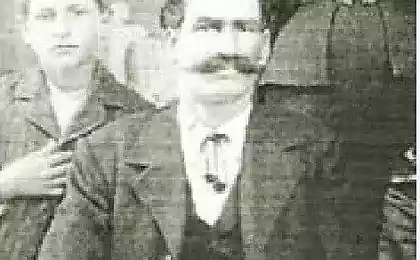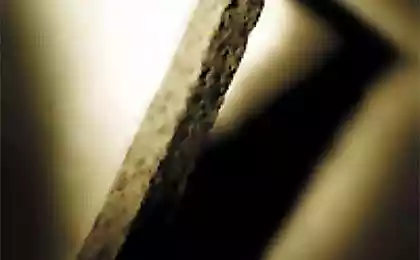852
At gunpoint from a soulless mechanism
Modern weapons are less in need of the person in the conduct of combat
The development of military technology has led to an opponent who is not able to think, but the decisions are made in a split second. He does not know pity and never takes prisoners has almost without fail - but not always able to distinguish friend from foe ...
It all started with a torpedo ...
... And to be precise, it all started with the problem of accuracy of shooting. And not rifle and even artillery. The question arose before the edge of the XIX century sailors who faced with a situation where their very expensive "torpedoes" were off target. This is understandable: they are moving very slowly, and the enemy is not standing still, waiting. Maneuver a ship for a long time was the most reliable method of protection against torpedoes.
Of course, with increasing speed torpedoes dodging them becomes more difficult, so the designers have spent most of the forces it to do so. But why not go the other way and not try to adjust the exchange rate is already moving torpedo? Ask this question, the famous inventor Thomas Edison (Thomas Alva Edison, 1847-1931) paired with the less famous Sims Winfield (Winfield Scott Sims, 1844) introduced in 1887 electric torpedo, which binds to the mine ship four wires. The first two - fueled its engine, and the second - is used to control the rudders. The idea, however, was not a new one, something like trying to design before, but the torpedo Sims-Edison was the first taken into service (US and Russia) and produced by moving a remote-controlled weapon.
Marines in Iraq since the third generation anti-tank complex "Dart» (FGM-148 Javelin). Homing "grasps" the infrared image of the target and the warhead explodes from hitting the armor. Photo: Sgt Mauricio Campino, USMC

And she had only one drawback - the power cord. As for the thin wire control, and they are now used in most modern types of weapons, such as anti-tank guided missile (ATGM) .However wire length limits the "Effective range" of such shells. The problem at the very beginning of the XX century has helped to solve a completely peaceful radio. Russian inventor Popov (1859-1906), as well as the Italian Marconi (Guglielmo Marconi, 1874-1937), came up with something that allows people to communicate with each other and not kill each other. But as you know, science can not always afford to pacifism, because it is driven by military orders. Among the inventors of the first radio-controlled torpedoes were Nikola Tesla (Nikola Tesla, 1856-1943) and the outstanding French physicist Edouard Branly (Édouard Eugène Désiré Branly, 1844-1940). And while their offspring were more like submerged in water propelled boats with superstructures and antennas, the method of management techniques for radio signal became, without exaggeration, a revolutionary invention! Children's toys and drones, remote control car alarm and managed to land the spacecraft - all offspring of those clunky machines.
Still, even such a torpedo, albeit remote, but were aimed person - which sometimes tend to miss. Delete the "human factor" has helped the idea of homing weapons, the ability to find the target and maneuver yourself to it without human intervention. At first, the idea expressed in fiction literary works. But the war between man and machine is no longer a fantasy much sooner than we expect.
Soviet antitank missile system "Fagot". Adopted in 1970. Wire-guided missile, it can fly up to 2 km and hit a target moving at a speed of not more than 60 km / h
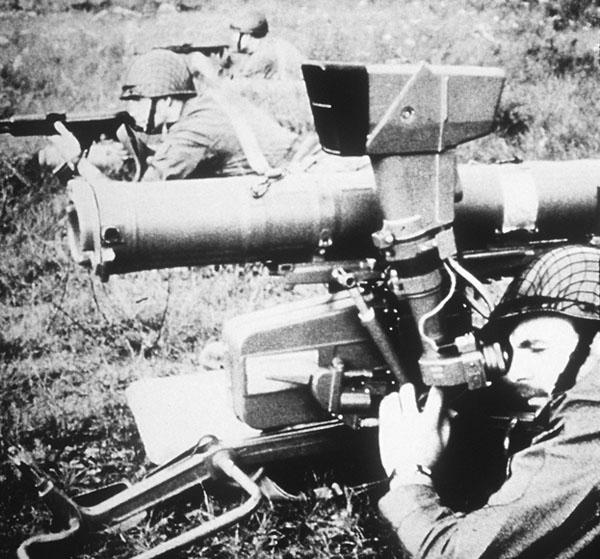
Vision and hearing electronic sniper
Over the past twenty years the US Army has participated four times in major local conflicts. And every time they began to turn, through television, in a kind of show, to create a positive image of the achievements of American engineering. Precision-guided weapons, guided bombs, the purpose of finding their own missiles, unmanned reconnaissance aircraft, battle management using orbiting satellites - all this was to shake the imagination of ordinary people and prepare them for new military spending.
But the Americans were not original. Propaganda various "miracle weapon" in the twentieth century - a common occurrence. It is widely conducted in the Third Reich, although the Germans had no technical capability to shoot its application, and observe the regime of secrecy, they, too, could boast a variety of technologies - which looked even more surprising for the time. And radio-controlled bomb PC-1400X was not the most impressive of them.
At the beginning of World War II in collisions with powerful royal navy, defending the British Isles, the German Luftwaffe and U-Boat Waffen suffered heavy losses. Increased anti-aircraft and anti-submarine weapons, supplemented by the latest technology, making the British ships more and more secure, and therefore more dangerous targets.
Storage torpedoes the British Army during World War II. Photo: OSS from the collection of the National Archives
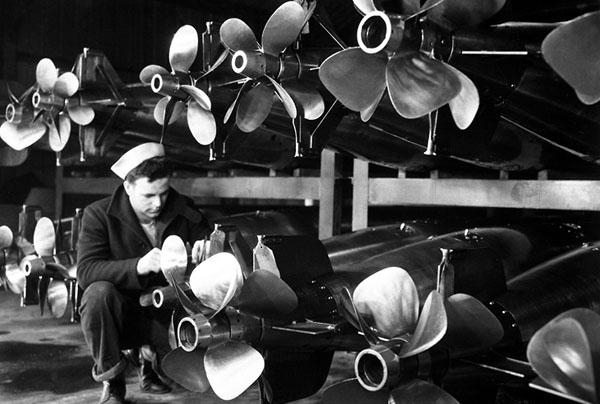
But German engineers began working on this problem before its occurrence. Since 1934, they pored over the creation of a torpedo T-IV «Falke», which had a passive acoustic homing system (its prototype was developed earlier in the USSR), responsive to the noise of ship propellers. As more advanced TV «Zaunkonig», it was intended to increase the accuracy of fire - which was especially important when launching the torpedo was conducted from long range, safer for submarines, or in a complex maneuver battlefield. For the same aircraft in 1942 it was created Hs-293, which has become, in fact, the first anti-ship cruise missile. Several countries in the form of construction was dumped from the plane a few kilometers from the ship, out of range of its anti-aircraft guns, accelerates and planned to target controlled by radio.
Weapons looked impressive for its time. But its effectiveness has been small: the target were only 9% of homing torpedoes, and only about 2% of the administered rocket bombs. These inventions require a deep revision than after the war and took up the victorious allies.
Still, it is missile and rocket weapons World War II, starting with "Katyusha" and ending with huge V-2, became the basis for the development of new systems, which have become the basis of all modern arsenals. Why is it a rocket? Is their advantage only in the range of flight? Perhaps they have chosen for further development also because the designers saw these "aerial torpedo" ideal for creating managed projectile in flight. And first of all such weapons needed to combat aircraft - given that the aircraft is a high-speed maneuver purpose.
However, to do this on the wire, keeping the goal in sight of his eyes, as the German Ruhrstahl X-4, it was impossible. This method is still rejected by the Germans themselves. Fortunately, the human eye even before the war, came up with a good replacement - radar. An electromagnetic pulse is sent in a certain direction, back reflected from the target. By the delay time of the reflected pulse can measure the distance to the target and change the carrier frequency - the speed of its movement. The anti-aircraft S-25, in 1954 he joined the Soviet Army, the missile is controlled by radio and control commands calculated by the difference coordinate missiles and target measured radar. Two years later came the famous P-75, which was not only able to "carry" while 18-20 purposes, but also has good mobility - it can be relatively quickly move from place to place. Rockets of this particular complex reconnaissance plane shot down Powers, and then "filled up" hundreds of American aircraft in Vietnam!
The US anti-radar missile 'Shrike »(AGM-45 Shrike) at a meeting with the radar. Photo: US Navy

In the process of improving missile guidance radar systems are divided into three types. Semi-active it consists of located on board the rocket, the host radar that catches the reflected signal from the target, "illuminated" by the second station - radar target illumination, which is on the launch complex or a fighter aircraft, and "leads" the enemy. Its advantage is that the more powerful emitting station can hold in his arms on the goal rather considerable distance (400 km). In the active guidance systems has its own radiating radars, it is more independent and accurate, but its "outlook" is much narrower. Therefore, it is usually turned on only when approaching the target. Third, passive guidance system, has emerged as a clever solution to use the enemy's radar - a signal which she directs a missile. It is they, in particular, destroyed the enemy radars and SAM.
Not forgotten and the old, as the V-1 missile inertial guidance system. Her original simple design, which only reported the projectile necessary, a predetermined trajectory, now complemented by satellite navigation systems, correction, or the peculiar orientation of speeding underneath terrain - using altimeter (radar, laser) or a camcorder. Thus, for example, Soviet X-55 can not just "see" the terrain, but also to maneuver on her height, keeping close above the surface - to evade enemy radar. However, in its pure form, such a system is suitable only for hitting fixed targets, because it does not guarantee the accuracy of impact. So it is usually supplemented with other guidance systems, switched on the last step of the way, when approaching the goal.
In addition, the well known infrared, or heat, the guidance system. If it is the first model able to capture only the heat of hot gases, escaping from the nozzle of a jet engine, today their sensing range much higher. And these are the thermal head not only aiming at the MANPADS short range of the "Stinger" or "Eagle", but also rockets of class "air-to-air" (for example, the Russian R-73). However, they have other, more mundane target. It radiates warmth, not only the engine of the aircraft or helicopter, and vehicle armor, in the infrared spectrum can be seen even heat, which is isolated building (windows, air passages). However, these heads have called thermal imaging guidance, and they are able to see and distinguish the outlines goals, not just a formless spot.
Portable laser pointer (portable laser designator rangefinder) allows homing head not to be mistaken for the purpose. It highlights its short pulses are not visible to the eye, but is well recognized by the navigation system of the rocket. Photo: Staff Sgt. Cruz G. Sotelo / USMC
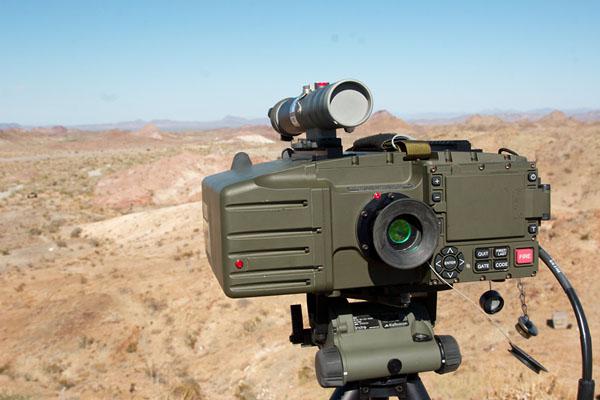
To some extent they can be attributed and semi-active laser guidance. It works very simple: he directed the laser at the target, and the missile flies neatly on a bright red dot. Laser head, in particular, are on the high-precision missiles "air-land" X-38ME (Russia) and the AGM-114K Hellfire (USA). Interestingly, they are often the target designated thrown into the rear of the enemy saboteurs with a sort of "laser pointers" (only powerful). In particular, since destroyed targets in Afghanistan and Iraq.
If infrared systems are used mainly at night, the television, on the other hand, works only during the day. The main part of the head of such a missile guidance - a video camera. With it comes an image on a monitor in the cockpit, which selects the target and presses the trigger. Further, it has a rocket directs the electronic "brain", which perfectly recognizes the target keeps it in the camera view and select the ideal trajectory. This is the principle of "fire - and forget", which is now considered to be the pinnacle of military technology.
However, to shift the entire responsibility for the conduct of combat vehicles on the shoulders was a mistake. Sometimes, proruha cases and on e-old woman - like it happened in October 2001 when, during firing exercises in the Crimea Ukrainian missile S-200 did not chose a training target, and a passenger airliner Tu-154. Such tragedies were not uncommon during the conflict in Yugoslavia (1999), Afghanistan and Iraq - the most high-precision weapons simply "been wrong," choosing a peaceful purpose, and not those that were assumed by people. However, they did not sober either military or designers who continue to design all new models of guns hanging on the wall, can not only own aim - but to shoot when deemed necessary ...
Rocket launcher XM501 with remote control. Each container 15 comprises rockets. Triggers the various containers are managed from a single console, the target missile sent by infrared head. Photo: US Army
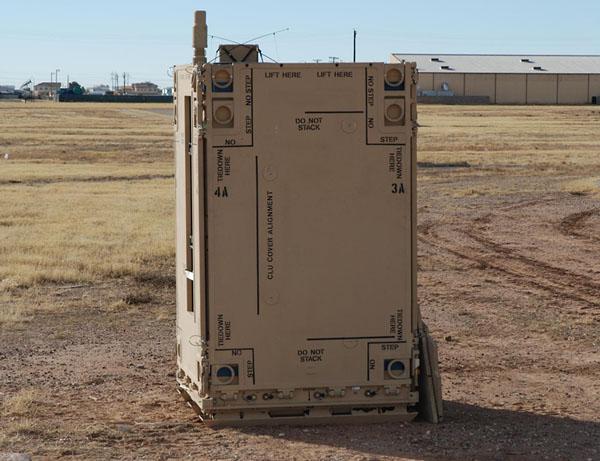
Sleeping in an ambush
Spring of 1945, hastily assembled for the defense of Berlin battalions "Volkssturm" held a brief military training. Directional them instructors from among retired soldiers trained for injury treatment of adolescents with hand grenade "Panzerfaust" and trying to cheer the lads, we have argued that this "miracle weapon" people could easily knock out any tank. And bashfully lowered their eyes, knowing that lie. Because the effectiveness of "Panzerfaust" was extremely small - only a huge amount of their allowed him to earn a reputation as storm armor. Each lucky shot had a dozen soldiers or militia, beveled queue or crushed tank tracks - and a few more of those who, abandoning their weapons, just escaped from the battlefield.
Years passed, the armies of the world there were more advanced anti-tank rocket launchers, then PTURC complexes, but the problem remained the same: grenade throwers and operators were killed, often without even having time to make your shot. For the army, who valued his soldiers and did not want to overwhelm the enemy armored vehicles their bodies, it has become a very serious problem. But the protection of tanks and constantly improved, including the active fire. There was even a special type of combat vehicles (BMPT), whose task is to detect and destroy enemy "faustnikov." In addition, the potentially dangerous areas of the battlefield can be pre "worked through" by artillery or air strike. Cassette shrapnel, much less thermal and "vacuum" (ERD) shells and bombs left little chance even to those who hid in the bottom of the trench.
However, there is a "fighter" who is not afraid of death, and that is not a pity to sacrifice - because it is intended for this. This anti-tank mine. Weapons of mass use in World War II, still remains a serious threat to the entire land of military equipment. However, the classic mine is not perfect. For boom sections need to arrange their defense dozens, and sometimes hundreds, and there is no guarantee that they will not detect the enemy and neutralize. More successful in this regard seems to Soviet TM-83, which is not established in the way of possible routes of enemy armored vehicles and the side - for example, the roadside, where she will not seek engineers. Approximation of target it lets you know seismic sensors responsive to fluctuations in soil and includes an infrared "eye" - and that, in turn, closes the fuse, when the hot engine compartment front of the car is mine. And it explodes, throwing forward impact cumulative core, capable of hitting the armor at a distance of up to 50 m. But even being discovered, the TM-83 is not available to the enemy: it is enough man to approach her at a distance of ten meters as its sensors will work on his steps and heat body. The explosion - and the enemy sapper go home, covered with a flag.
Today, seismic sensors are increasingly used in the construction of various mines, displacing the traditional push fuses, "antennae" and "stretch". Their advantage is that they are able to "hear" moving object (equipment or human) long before he approached the mine itself. However, to approach it is unlikely to be able to, because these sensors are closed fuse much earlier.
Noncontact detonation device DDP-P "Hunting". It includes a five-minute, guided by the sound of footsteps. Illustration: «Warsaw pact mines» archive Oleg Walecki

Even more fantastic American mine seems M93 Hornet, as well as the development of similar Ukrainian nicknamed "Woodpecker" and a number of others, is still experimental development. Weapons of this type represents a complex consisting of a set of passive target detection sensors (seismic, acoustic, infra-red) and an antitank missile launcher.
Source:
The development of military technology has led to an opponent who is not able to think, but the decisions are made in a split second. He does not know pity and never takes prisoners has almost without fail - but not always able to distinguish friend from foe ...
It all started with a torpedo ...
... And to be precise, it all started with the problem of accuracy of shooting. And not rifle and even artillery. The question arose before the edge of the XIX century sailors who faced with a situation where their very expensive "torpedoes" were off target. This is understandable: they are moving very slowly, and the enemy is not standing still, waiting. Maneuver a ship for a long time was the most reliable method of protection against torpedoes.
Of course, with increasing speed torpedoes dodging them becomes more difficult, so the designers have spent most of the forces it to do so. But why not go the other way and not try to adjust the exchange rate is already moving torpedo? Ask this question, the famous inventor Thomas Edison (Thomas Alva Edison, 1847-1931) paired with the less famous Sims Winfield (Winfield Scott Sims, 1844) introduced in 1887 electric torpedo, which binds to the mine ship four wires. The first two - fueled its engine, and the second - is used to control the rudders. The idea, however, was not a new one, something like trying to design before, but the torpedo Sims-Edison was the first taken into service (US and Russia) and produced by moving a remote-controlled weapon.
Marines in Iraq since the third generation anti-tank complex "Dart» (FGM-148 Javelin). Homing "grasps" the infrared image of the target and the warhead explodes from hitting the armor. Photo: Sgt Mauricio Campino, USMC

And she had only one drawback - the power cord. As for the thin wire control, and they are now used in most modern types of weapons, such as anti-tank guided missile (ATGM) .However wire length limits the "Effective range" of such shells. The problem at the very beginning of the XX century has helped to solve a completely peaceful radio. Russian inventor Popov (1859-1906), as well as the Italian Marconi (Guglielmo Marconi, 1874-1937), came up with something that allows people to communicate with each other and not kill each other. But as you know, science can not always afford to pacifism, because it is driven by military orders. Among the inventors of the first radio-controlled torpedoes were Nikola Tesla (Nikola Tesla, 1856-1943) and the outstanding French physicist Edouard Branly (Édouard Eugène Désiré Branly, 1844-1940). And while their offspring were more like submerged in water propelled boats with superstructures and antennas, the method of management techniques for radio signal became, without exaggeration, a revolutionary invention! Children's toys and drones, remote control car alarm and managed to land the spacecraft - all offspring of those clunky machines.
Still, even such a torpedo, albeit remote, but were aimed person - which sometimes tend to miss. Delete the "human factor" has helped the idea of homing weapons, the ability to find the target and maneuver yourself to it without human intervention. At first, the idea expressed in fiction literary works. But the war between man and machine is no longer a fantasy much sooner than we expect.
Soviet antitank missile system "Fagot". Adopted in 1970. Wire-guided missile, it can fly up to 2 km and hit a target moving at a speed of not more than 60 km / h

Vision and hearing electronic sniper
Over the past twenty years the US Army has participated four times in major local conflicts. And every time they began to turn, through television, in a kind of show, to create a positive image of the achievements of American engineering. Precision-guided weapons, guided bombs, the purpose of finding their own missiles, unmanned reconnaissance aircraft, battle management using orbiting satellites - all this was to shake the imagination of ordinary people and prepare them for new military spending.
But the Americans were not original. Propaganda various "miracle weapon" in the twentieth century - a common occurrence. It is widely conducted in the Third Reich, although the Germans had no technical capability to shoot its application, and observe the regime of secrecy, they, too, could boast a variety of technologies - which looked even more surprising for the time. And radio-controlled bomb PC-1400X was not the most impressive of them.
At the beginning of World War II in collisions with powerful royal navy, defending the British Isles, the German Luftwaffe and U-Boat Waffen suffered heavy losses. Increased anti-aircraft and anti-submarine weapons, supplemented by the latest technology, making the British ships more and more secure, and therefore more dangerous targets.
Storage torpedoes the British Army during World War II. Photo: OSS from the collection of the National Archives

But German engineers began working on this problem before its occurrence. Since 1934, they pored over the creation of a torpedo T-IV «Falke», which had a passive acoustic homing system (its prototype was developed earlier in the USSR), responsive to the noise of ship propellers. As more advanced TV «Zaunkonig», it was intended to increase the accuracy of fire - which was especially important when launching the torpedo was conducted from long range, safer for submarines, or in a complex maneuver battlefield. For the same aircraft in 1942 it was created Hs-293, which has become, in fact, the first anti-ship cruise missile. Several countries in the form of construction was dumped from the plane a few kilometers from the ship, out of range of its anti-aircraft guns, accelerates and planned to target controlled by radio.
Weapons looked impressive for its time. But its effectiveness has been small: the target were only 9% of homing torpedoes, and only about 2% of the administered rocket bombs. These inventions require a deep revision than after the war and took up the victorious allies.
Still, it is missile and rocket weapons World War II, starting with "Katyusha" and ending with huge V-2, became the basis for the development of new systems, which have become the basis of all modern arsenals. Why is it a rocket? Is their advantage only in the range of flight? Perhaps they have chosen for further development also because the designers saw these "aerial torpedo" ideal for creating managed projectile in flight. And first of all such weapons needed to combat aircraft - given that the aircraft is a high-speed maneuver purpose.
However, to do this on the wire, keeping the goal in sight of his eyes, as the German Ruhrstahl X-4, it was impossible. This method is still rejected by the Germans themselves. Fortunately, the human eye even before the war, came up with a good replacement - radar. An electromagnetic pulse is sent in a certain direction, back reflected from the target. By the delay time of the reflected pulse can measure the distance to the target and change the carrier frequency - the speed of its movement. The anti-aircraft S-25, in 1954 he joined the Soviet Army, the missile is controlled by radio and control commands calculated by the difference coordinate missiles and target measured radar. Two years later came the famous P-75, which was not only able to "carry" while 18-20 purposes, but also has good mobility - it can be relatively quickly move from place to place. Rockets of this particular complex reconnaissance plane shot down Powers, and then "filled up" hundreds of American aircraft in Vietnam!
The US anti-radar missile 'Shrike »(AGM-45 Shrike) at a meeting with the radar. Photo: US Navy

In the process of improving missile guidance radar systems are divided into three types. Semi-active it consists of located on board the rocket, the host radar that catches the reflected signal from the target, "illuminated" by the second station - radar target illumination, which is on the launch complex or a fighter aircraft, and "leads" the enemy. Its advantage is that the more powerful emitting station can hold in his arms on the goal rather considerable distance (400 km). In the active guidance systems has its own radiating radars, it is more independent and accurate, but its "outlook" is much narrower. Therefore, it is usually turned on only when approaching the target. Third, passive guidance system, has emerged as a clever solution to use the enemy's radar - a signal which she directs a missile. It is they, in particular, destroyed the enemy radars and SAM.
Not forgotten and the old, as the V-1 missile inertial guidance system. Her original simple design, which only reported the projectile necessary, a predetermined trajectory, now complemented by satellite navigation systems, correction, or the peculiar orientation of speeding underneath terrain - using altimeter (radar, laser) or a camcorder. Thus, for example, Soviet X-55 can not just "see" the terrain, but also to maneuver on her height, keeping close above the surface - to evade enemy radar. However, in its pure form, such a system is suitable only for hitting fixed targets, because it does not guarantee the accuracy of impact. So it is usually supplemented with other guidance systems, switched on the last step of the way, when approaching the goal.
In addition, the well known infrared, or heat, the guidance system. If it is the first model able to capture only the heat of hot gases, escaping from the nozzle of a jet engine, today their sensing range much higher. And these are the thermal head not only aiming at the MANPADS short range of the "Stinger" or "Eagle", but also rockets of class "air-to-air" (for example, the Russian R-73). However, they have other, more mundane target. It radiates warmth, not only the engine of the aircraft or helicopter, and vehicle armor, in the infrared spectrum can be seen even heat, which is isolated building (windows, air passages). However, these heads have called thermal imaging guidance, and they are able to see and distinguish the outlines goals, not just a formless spot.
Portable laser pointer (portable laser designator rangefinder) allows homing head not to be mistaken for the purpose. It highlights its short pulses are not visible to the eye, but is well recognized by the navigation system of the rocket. Photo: Staff Sgt. Cruz G. Sotelo / USMC

To some extent they can be attributed and semi-active laser guidance. It works very simple: he directed the laser at the target, and the missile flies neatly on a bright red dot. Laser head, in particular, are on the high-precision missiles "air-land" X-38ME (Russia) and the AGM-114K Hellfire (USA). Interestingly, they are often the target designated thrown into the rear of the enemy saboteurs with a sort of "laser pointers" (only powerful). In particular, since destroyed targets in Afghanistan and Iraq.
If infrared systems are used mainly at night, the television, on the other hand, works only during the day. The main part of the head of such a missile guidance - a video camera. With it comes an image on a monitor in the cockpit, which selects the target and presses the trigger. Further, it has a rocket directs the electronic "brain", which perfectly recognizes the target keeps it in the camera view and select the ideal trajectory. This is the principle of "fire - and forget", which is now considered to be the pinnacle of military technology.
However, to shift the entire responsibility for the conduct of combat vehicles on the shoulders was a mistake. Sometimes, proruha cases and on e-old woman - like it happened in October 2001 when, during firing exercises in the Crimea Ukrainian missile S-200 did not chose a training target, and a passenger airliner Tu-154. Such tragedies were not uncommon during the conflict in Yugoslavia (1999), Afghanistan and Iraq - the most high-precision weapons simply "been wrong," choosing a peaceful purpose, and not those that were assumed by people. However, they did not sober either military or designers who continue to design all new models of guns hanging on the wall, can not only own aim - but to shoot when deemed necessary ...
Rocket launcher XM501 with remote control. Each container 15 comprises rockets. Triggers the various containers are managed from a single console, the target missile sent by infrared head. Photo: US Army

Sleeping in an ambush
Spring of 1945, hastily assembled for the defense of Berlin battalions "Volkssturm" held a brief military training. Directional them instructors from among retired soldiers trained for injury treatment of adolescents with hand grenade "Panzerfaust" and trying to cheer the lads, we have argued that this "miracle weapon" people could easily knock out any tank. And bashfully lowered their eyes, knowing that lie. Because the effectiveness of "Panzerfaust" was extremely small - only a huge amount of their allowed him to earn a reputation as storm armor. Each lucky shot had a dozen soldiers or militia, beveled queue or crushed tank tracks - and a few more of those who, abandoning their weapons, just escaped from the battlefield.
Years passed, the armies of the world there were more advanced anti-tank rocket launchers, then PTURC complexes, but the problem remained the same: grenade throwers and operators were killed, often without even having time to make your shot. For the army, who valued his soldiers and did not want to overwhelm the enemy armored vehicles their bodies, it has become a very serious problem. But the protection of tanks and constantly improved, including the active fire. There was even a special type of combat vehicles (BMPT), whose task is to detect and destroy enemy "faustnikov." In addition, the potentially dangerous areas of the battlefield can be pre "worked through" by artillery or air strike. Cassette shrapnel, much less thermal and "vacuum" (ERD) shells and bombs left little chance even to those who hid in the bottom of the trench.
However, there is a "fighter" who is not afraid of death, and that is not a pity to sacrifice - because it is intended for this. This anti-tank mine. Weapons of mass use in World War II, still remains a serious threat to the entire land of military equipment. However, the classic mine is not perfect. For boom sections need to arrange their defense dozens, and sometimes hundreds, and there is no guarantee that they will not detect the enemy and neutralize. More successful in this regard seems to Soviet TM-83, which is not established in the way of possible routes of enemy armored vehicles and the side - for example, the roadside, where she will not seek engineers. Approximation of target it lets you know seismic sensors responsive to fluctuations in soil and includes an infrared "eye" - and that, in turn, closes the fuse, when the hot engine compartment front of the car is mine. And it explodes, throwing forward impact cumulative core, capable of hitting the armor at a distance of up to 50 m. But even being discovered, the TM-83 is not available to the enemy: it is enough man to approach her at a distance of ten meters as its sensors will work on his steps and heat body. The explosion - and the enemy sapper go home, covered with a flag.
Today, seismic sensors are increasingly used in the construction of various mines, displacing the traditional push fuses, "antennae" and "stretch". Their advantage is that they are able to "hear" moving object (equipment or human) long before he approached the mine itself. However, to approach it is unlikely to be able to, because these sensors are closed fuse much earlier.
Noncontact detonation device DDP-P "Hunting". It includes a five-minute, guided by the sound of footsteps. Illustration: «Warsaw pact mines» archive Oleg Walecki

Even more fantastic American mine seems M93 Hornet, as well as the development of similar Ukrainian nicknamed "Woodpecker" and a number of others, is still experimental development. Weapons of this type represents a complex consisting of a set of passive target detection sensors (seismic, acoustic, infra-red) and an antitank missile launcher.
Source:
